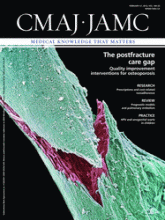Abstract
Background: Postfracture care is suboptimal, and strategies to address this major gap in care are necessary. We investigated whether notifications sent by mail to physicians and patients would lead to improved postfracture care.
Methods: We conducted a randomized controlled trial (ClinicalTrials.gov identifier NCT00594789) in the province of Manitoba, Canada, from June 2008 to May 2010. Using medical claims data, we identified 4264 men and women age 50 years or older who recently reported major fractures, and who had not undergone recent bone mineral density testing or treatment for osteoporosis. Participants were randomized to three groups: group 1 received usual care (n = 1480), patients in group 2 had mailed notification of the fracture sent to their primary care physicians (n = 1363), and group 3 had notifications sent to both physicians and patients (n = 1421). Bone mineral density testing and the start of pharmacologic treatment for osteoporosis within the following 12 months were documented.
Results: Among participants in group 1 (usual care), 15.8% of women and 7.6% of men underwent testing for bone mineral density or started pharmacologic treatment for osteoporosis. Outcome measures improved among participants in group 2 (30.3% of women and 19.0% of men, both p < 0.001) and group 3 (34.0% of women and 19.8% of men, both p < 0.001). No additional benefit was seen with patient notification in addition to physician notification. Combining groups 2 and 3, the absolute increase for the combined end point of bone mineral density testing or pharmacologic treatment was 14.9% (16.4% among women, 11.8% among men). The number needed to notify to change patient care was 7 (6 for women, 6 for men). The adjusted odds ratio (OR) to change patient care in group 2 was 2.45 (95% confidence interval [CI] 2.01–2.98); for group 3 the OR was 2.82 (95% CI 2.33–3.43).
Interpretation: This notification system provides a relatively simple way to enhance post-fracture care.
See related commentary by Majumdar on page 279 and at www.cmaj.ca/lookup/doi/10.1503/cmaj.111999








